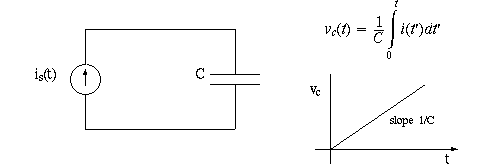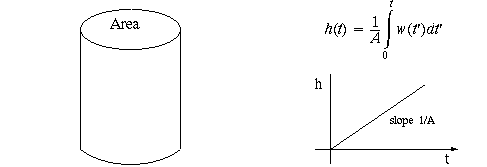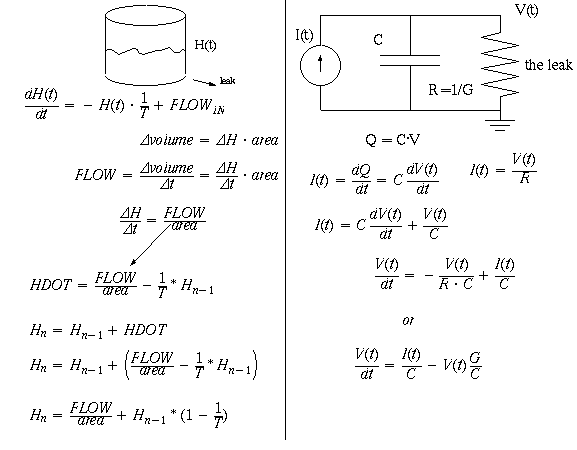Integrators, neural and electronic
READ RHSC2 part of Chapter 12, pages 346 - 359.
"integrate" the various parts of eye movements see Figure 12.2
Time scale:
1-10 msec: "trapped" transmitter
10-100 msec: membrane capacitance
minutes-lifetime: protein synthesis
100msec- many seconds (range of neuromuscular timing)
tapped delay line
positive feedback
push pull scheme of two filters in series
one tau in cerebellum, the other in the PPRF = paramedian pontine rf
Reading:
S. C. Cannon & D. A. Robinson, "Loss of the neural integrator
of the oculomotor system from brain stem lesions in monkey," J.
Neurophysiol 57: 1387-1409 (1987).
http://jn.physiology.org/cgi/reprint/57/5/1383.pdf
Where is fancy bred? In the heart or in the head? Where is the neural integrator?
in the cerebellum? PPRF?
They find evidence for the neural integrator controlling horizontal eye movements
by lesioning the medial vestibular and prepositus hypoglossi nuclei.
S. C. Cannon & D. A. Robinson, "The
final common integrator is in the prepositus and vestibular nuclei," pages
307- 311 in Adaptive Processes in Visual and Oculomotor Systems, edited
by Keller & Zee, 1986 [QP474.A33 on reserve]
1996: Cannon and Robinson argue for only
conjugate control to share a common integrator.
after kinate injection, data figures:
saccades show drift away from fixation;
OptoKinetic response shows no nystagmus when lights are turned off!
smooth pursuit is interrupted by saccades.
ALL THREE EFFECTS ARE WHAT YOU'D PREDICT IF THE INTEGRATOR WERE ELIMINATED!
Integration and integrators
You normally think of integration as a mathematical operation; here we want consider
the realization of integration in electronic, mechanical, chemical or neural hardware.
Properties of integration: it is a linear operation; it can be
approximated by summation.
In matlab use the QUAD( 'func', lim1, lim2) which is

Simulink icon implements this integrator: In practice, hardware integrators may
need to be reset (maybe to zero, maybe to an initial condition), may have saturation
limits, and may have leaks. Integrators have memory; their current output
is influenced by past input.
The need for integrator(s)
FIR and IIR filters as integrators
models for integrators
capacitor vs flip flop
recursive (=feedback) vs non-recursive
leaky, forgetful
reset
nerve cell models
Demo: The leaky integrator
The leaky bucket from 095 shelf. Try a leaky cup for second order
system.
Threshold & Saturation
A first order circuit has only one energy storage element in it.
See Desoer & Kuh (1969) or Nilsson (EN52 book)
...current and voltage pulses to create init conditions.
Can a first order circuit have only a capacitor and a source in it?

Like filling a bucket with water from a hose. An electronic integrator.
Now consider a bucket being filled by a hose. (or the filling
of a heart ventricle by flow in from a blood vessel.)
The hose is sending Ws cc/sec of water into a bucket of diameter d= 24 cm.
Say Ws = 100 cc/sec.
The area of bucket = A = p 144 cm^2.
The height increases at a rate Ws/A = 100/p 144 cm/sec

The height of water in the bucket is an indication of how much water has poured into the bucket
since t=0. The bucket's area is like capacitance. The bucket is an integrator.
Now what if there's a hole in the bucket, near the bottom? Water
flows out of the hole at a rate proportional to the height of the water in the bucket.
Say the hole can be described by a leak rate in cc/sec = a�h.
Since h has dimensions of cm, then a must have dimensions of cm^2/sec. How
fast does the height of the bucket drop if the bucket is filled and the inlet stopped?
ANS: At a rate hdot = -a�h/A.
Notice that we divide alpha by A to get the right units for the
differential equation!
Now what if the input hose and the leak are active at the same
time?

Separating variables,

If we make the substitution of variables

then we have an equation

and need to integrate,

which has the indefinite integral on the left of ln(u) and the definite solution

where initial condition h(0) comes in because of the integral limits. Clearing the
natural logarithm and assuming initial condition h(0) is zero,

and solving for h(t)


where t = A/a.
Asymptote is where dh/dt = 0

The leaky integrator! A realistic model for many real integrators. A first
order system.
Set dh/dt = 0 to find the asymptotic value shown.
Does the time constant make sense? Yes: If the Area of the bucket
increases, then it will take longer to reach the value dh/dt = 0. If the leak a
increases then it will take a shorter time to reach the asymptote and the resulting
height will be less.
Back to the capacitor being "filled" by the current source. Attach a conductance leak:

Notice the equations of the RC first order circuit and the leaky integrator are the same, except
for the labels used. The resistor (conductor G) plays the role of the leak, and limits how much
charge can accumulate on the capacitor. Capacitance C is like the area of the bucket.
Is my bucket nonlinear? It doesn't have a constant area, and the leak is not at the bottom where
h=0.
What about the initial condition h(0)? Go back to the equation with h(0) in it.

take the exponential of both sides,


We know Ws / a is the final value, what Circuits books call hf. So

which is an equation from Nilsson, Circuits book. .
The total response = the final response plus a decaying exponential which has the
final response subtracted from the initial condition times e-t/t , where t is the
time constant of the system.
NOTE: THE DIFF-EQ COULD BE SOLVED BY LAPLACE TRANSFORM.
LEAKY INTEGRATOR computation by coding

TAU is the time constant of leakage.
OR USE ODE23 IN MATLAB
Integrators have memory
The initial condition; dependence on the past input
General form for a sensory motor system

can represent the eye muscles, with tau=150 msec
We want something times H(D) times E(D) times input to give an answer of 1.
Input is position, since velocity is the signal for SP and VOR.
can we therefore say:

which is the summation needed in Carpenter's Fig 12.3
In general, we know sensory input characteristics
& muscle load characteristics kq + r dq/dt

so part of the mechanical system is an integrator.
Is the whole thing a leaky integrator? Yes!

where D is the input...
Can be modeled as a negative feedback system.
What's its time constant? r/k. Dimensional analysis...
Can have its time constant increased by positive feedback of gain less than k:

Become a "perfect" integrator.
look at overall performance

Suppose we want IN = OUT (as we do in smooth tracking or VOR).
If these are linear boxes, we can lump sensory + motor together & find
the inverse function. Straightforward with the algebra of
Laplace transforms!
What do we know about sensory? We may take the derivative
of the input (motion detector). What do we know about motor? The input to motor-spikes/sec
on motoneuron = force of muscle contraction-may be working against a spring + dashpot.
In the case of muscle as spring what is needed in between is an integrator.
"Do the math" in Laplace transform terms: at the output we know

What is D(s)? D(s) = CNS(s)�H(s)�In(s),
on the input side we know that position P(s) is differentiated for "slip" type error, so

is the form since we want input to equal output after its all over. track position:
therefore is

implies

which is a statement of fig 12.3 in RHSC2
k/s is the neural integrator. Notice that it is correcting for position k.
Evidence for neural integrator in eye movement control
Vergence, saccades, VOR, optokinesis, smooth pursuit.
A word about vergence
Vergence is slow.
Disparity is closed loop vergence--
Accommodation is open loop vergence.
On page 346: "We saw in �5.2.2 that under open-loop conditions, vergence velocity
is directly proportional to disparity error at any moment." RHSC2 takes this
ramp of position, due to velocity, to suggest an integrator in the control system.
Open the loop and find an integrator! Use Disparity stimulus.
Fig. 5.9 measure Deye-mov, use that to move stimulus.
And see Fig 5.14 Get triangle-for-square waves ?
BONUS: Saccade + Vergence--see Fig. 5.17, 5.18 in RHSC2
Saccades
The ramp part of the pulse-step control suggests an integrator. A saccade is a rapid ballistic
response to position error. The position error finds (generates, gates) a time tau during which
r*speed is active, and the eye is moved by "speed" to the correct position. When it reaches the
correct position, position error is zero but the system continues to output the correct value of
"D." There must have been an integrator building up during time tau, but one that stops
changing when POS is reached.

The argument for this integral is zero when POS is reached. It is NOT feedback, because POS
doesn't change during the saccade.
Smooth pursuit & Optokinesis
For optokinesis, the situation is like the storage loop in VOR: The velocity storage loop needed
to handle zero error has an integrator as its consequence.
A pure velocity term tells the eye at what speed to move, but an integration is needed to correct
for position. RAMP FUNCTIONS FROM INTEGRATION. And see Fig 3.25
need to restore position from speed detectors
look for ramps!
DA Robinson, "Integrating with neurons,"
Ann Rev of Neurosci 12: 33-45 (1989).
Examples of integration:
1. volume of blood in ventricle is integral of inflow
2. Position of dc motor shaft is integral of current into motor
3. Electric meter on your house integrates power delivered
Integrators have large gain at low frequency.
When integrators are used in negative feedback systems they minimize errors in the steady
state.
"...when engineers became interested in biological control systems, they took it for granted
that integrators were everywhere-how else could all these control systems possibly work?
The oculomotor system offers an especially clear example: The retina senses the error between
the eye (fovea) and the target, and the system turns the eye until the error is zero-a simple
negative feedback scheme. Moreover, when the goal is reached, a constant eye deviation
(output) is maintained while the error (input) is zero. But that is just what an integrator
does-it holds signals in the absence of new information. Indeed, the only way its output can be
constant is if the input error is zero-the desired condition. So obviously the oculomotor
system had an integrator and to the bioengineer this idea was so obvious as to be trivial.
To the neurophysiologist a neural integrator seemed exotic, but, so long as it only appeared in
top-down, black-box models it could be relegated to "higher centers" and ignored. This was
not however, the case for the vestibuloocular reflex. By the early 1960s, it was clear that the
signal from the semicircular canals, coded in the rate modulation of the primary afferents, was
head velocity. The discharge rate of motoneurons, on the other hand, largely determined eye
position. If a constant head velocity is to make the eyes move at a constant velocity, the
motoneurons must respond to the time integral of the canal signal. This integrator was not hidden
under a feedback loop-it was the major signal-processing element in a short, well-defined
pointine reflex. It could not be ignored without also ignoring the main function of the reflex."
EXPLAIN THE PART IN ITALICS: Key concept--the canal signal is constant, but the
OMN signal must be increasing linearly. An integrator must intervene.
consider

The signal from the vestibular nerve can be used to form the

term.
But an integrator is needed for the

term. The first way bioengineers felt that integration was
done was by derivative feedback, from proprioceptors:

Neural integration is NOT done by derivative feedback.
However it works (push-pull involved) it has a leak time of about
25 seconds
Robinson '89, page 36.
Gaze holding in the dark represents the output of the visuo-motor integrator
reprise: Location of the integrator
Find the integrator, lesion it, and what do you expect to
happen? No more ramp responses. No more holding action.
RHSC2 on page 354 says "Only two sites for the neural
integrator are at all probable: the brainstem, more particularly the paramedian
pontine reticular formation (PPRF) and the cerebellum." On the other hand,
see title of paper below: other sites in brainstem...
Integrator action is completely abolished when the "vestibulo-prepositus
complex" is abolished.
SEARCH FOR EYE POSITION SIGNALS; that will be the output of
the neural integrator. The superior and rostral-medial nuclei of the vestibular
nuclei carry eye position information. so do signals in the prepositus hypoglossi,
right next door.
The lesion study showed that all eye movement control systems
shared the same integrator.
FIGURE 12.10
Robinson? "...recent observations show loss of integrator function after
electrolytic lesions of either the vestibular or prepositus nuclei...and after
excito-toxin lesions of both the vestibular and prepositus nuclei..."
RHSC2 �12.2, page 346, "The oculomotor integrator"
from page 348 of RHSC2: A lesion which destroys only a pathway
to the integrator may give false evidence that there is more than one integrator...
"Powerful theoretical argument against the existence of more than one integrator...What
if each integrator is being driven toward its own saturation point? Quick phase
resets the integrator...
VESTIBULAR, OPTOKINETIC, AND SACCADIC INTEGRATORS ARE ONE,
AND VERY LIKELY THIS INTEGRATOR IS USED IN VERGENCE AND SMOOTH PURSUIT.
See figure on page 354. Location of integrator. Outer loop has 20 sec time constant, inner loop
has 1 sec time constant...
We need the fact that the motor equation is our usual spring-drag-(inertia) set-up, with
inertia discounted.
Real integrators (analog) are leaky
How can we describe a leaky integrator?
Neural hardware for integration
Consider a taped delay line feeding into a summation unit:

Review of the work of student Cannon, with his lateral inhibition model for an integrator.
Robinson, Vis. Res. 26: 91-99
(1986) for answer to question below
Summary
* Integrators are a general hardware need in motor control
(remember primary afferents)
* Integrators in the service of diff eq's
show examples for 1st and 2nd order constant coefficient linear...
Laplace xform of delT and d/dt
* the need for integration to compensate for sensory differentiation
* Evidence for integrator(s), 4 kinds of eye movements
* one integrator vs many
too much repair for many integrators feeding one motor plant?
evidence: saturation in the nystagmus paradigm
* location of the neural integrator?
cerebellum PPRF Vestibular nuclei/prepositus
* MODEL: positive feedback with gain of precisely 1.0
gain of <1 for leaky integrator
* capacitors, counters & chemicals
* control of integrator reset
%----------- archive notes below ----------------
What can be done to make a (neural) integrator?
Positive feedback (Robinson paper)
If a cell inhibits its neighbor and the neighbor inhibits the cell, we have positive
feedback...
VCO & Counter
OpAmp & Capacitor
Recursive filter
Release transmitter w/o destruction (water in the bucket...)
diffusion or enzyme action = THE LEAK
FLIP FLOP: TWO NEGATIVES MAKE A POSITIVE
(WITH SATURATION)

Is memory a high gain positive feedback
integrator with saturation?
GOAL OF musculoskeletal SYSTEM: try reaching\-to end up with the arm/eye on
the target
digital filters; non-recursive, weighted inputs, covolution...
just where do leaky integrators come in?
1992: Time flies like an arrow. why have an integrator?
Is the eye muscle plant an integrator?
Integrators have memory, and can be used to mimic delay...
RHSC2 fig 12.2 & 12.10
push-pull integrator has "reset" IS IT A FLIP FLOP?
ONE LEAKY integrator output becomes the other's input, increase the TAU...
computer assignment for integrators...
The need for precise gain-of-one integrator
(smooth pursuit)
use feedback
What about the more general case?
This is, in general, a rather difficult DiffEq to solve for H, so we resort to LT
shortcut!














